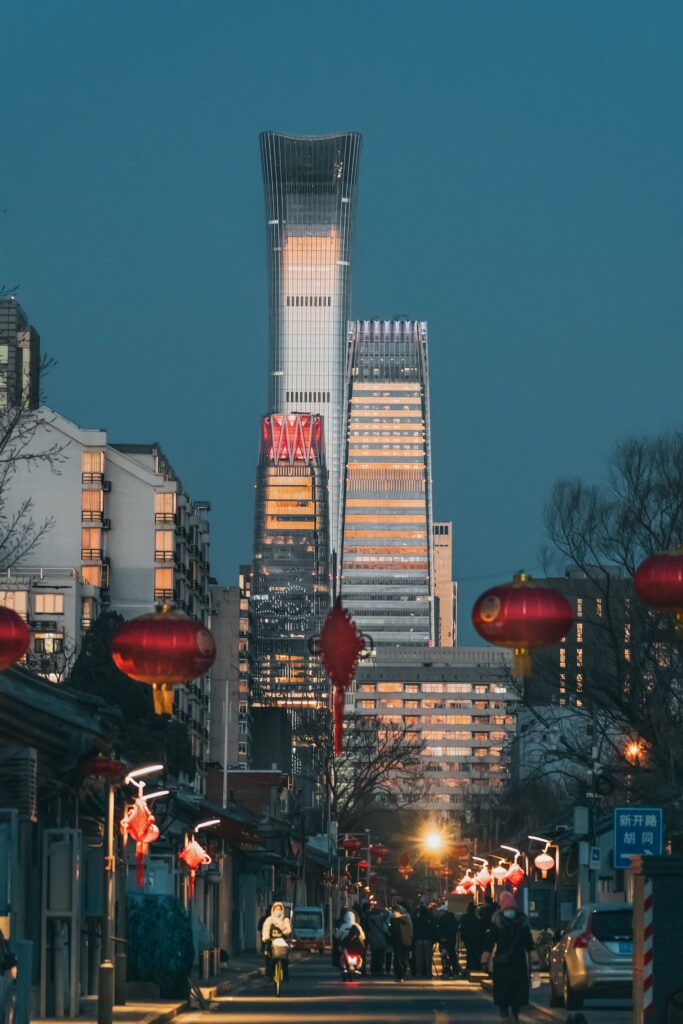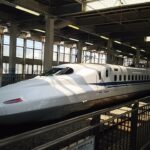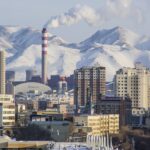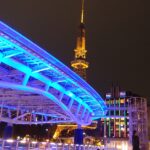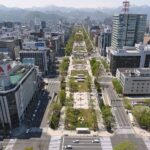Beijing has a vast and effective public transportation system that includes a sophisticated network of buses, metro lines, taxis, and even bike-sharing programs. With a total of 27 lines (22 rapid transit lines) and more than 500 stations, the Beijing Metro is the busiest metro system in the world. With over 1,000 routes, buses in Beijing offer convenience and affordability. With a base fare of 13 RMB for the first 3 km, taxis are another well-liked mode of transportation in Beijing. There are also bike-sharing programs that enable users to pick up and drop off bicycles everywhere in the city.
Basic information about the Metro system in Beijing
With 27 lines and more than 500 stops, the metro system in Beijing is the busiest in the entire globe. With 807 kilometers of track, it is the second-longest metro network worldwide. It gives people access to the suburbs around the city and links the city’s main tourist and business areas. Additionally, the metro has excellent connections to the airport and other transportation centers, making getting around simple. The Beijing MTR Corporation, which has been in business since 1969, runs the network. Because the price is reasonable, it’s a good choice for both locals and tourists.
The lines of the Beijing subway system
The capital and second-largest city in China is Beijing, which also happens to be the name of the city. An extensive network of subway lines provides service to the city, making it a significant hub for transit. The subway system in Beijing is consistently ranked as one of the busiest in the entire world, and the city’s infrastructure is heavily reliant on its metro lines.
There are currently 27 metro lines operating in Beijing, and an additional 3 lines are currently being constructed as part of the city’s subway expansion. Rapid access to many of Beijing’s most important locations is made possible by the city’s extensive subway system, which is supported by the Beijing Metro lines. Service to the suburbs is provided by lines 1, 2, and 13, and service to the airport is provided by the lines 5, 10, and Batong. Lines 1, 2, and 13 provide service from the city center to the suburbs. The Forbidden City and Olympic Park are two of the city’s most popular destinations that may be reached through Line 4, the city’s sole circular subway line. Line 8 is the longest line, and it connects the city center with the Tongzhou District. It travels in a north-to-south direction. Further service is provided across the city by the 6, 7, 9, and 14 lines of the city bus system.
The lines of the Beijing Suburban Railway were developed with the purpose of providing effective service to the suburbs located outside of the metropolis. Destinations such as Beijing West Railway Station, Beijing South Railway Station, and Beijing Capital International Airport can be reached using Lines S1, S2, S8, S9, S12, and S15.
There is nonstop service between the city’s central business district and Beijing Capital International Airport provided by the Beijing Airport Express lines. Lines A, B, and C provide service from the airport to important transit hubs in the city, while Line D provides service directly between the airport and the downtown area.
The Beijing Sanyuanqiao Airport Express line is the last option for passengers looking for transportation between the Beijing Capital International Airport and Sanyuanqiao Station. There is no other line in the city that provides direct service between the airport and the central business district as this one does.
The subway system in Beijing is an essential component of the city’s infrastructure. It offers fast and dependable service to important locations all across Beijing. The subway system in Beijing is one of the largest in the world and features 21 different lines. It is an essential component of daily life in the city.
Map of Beijing Metro 2023 – Free Download in PDF
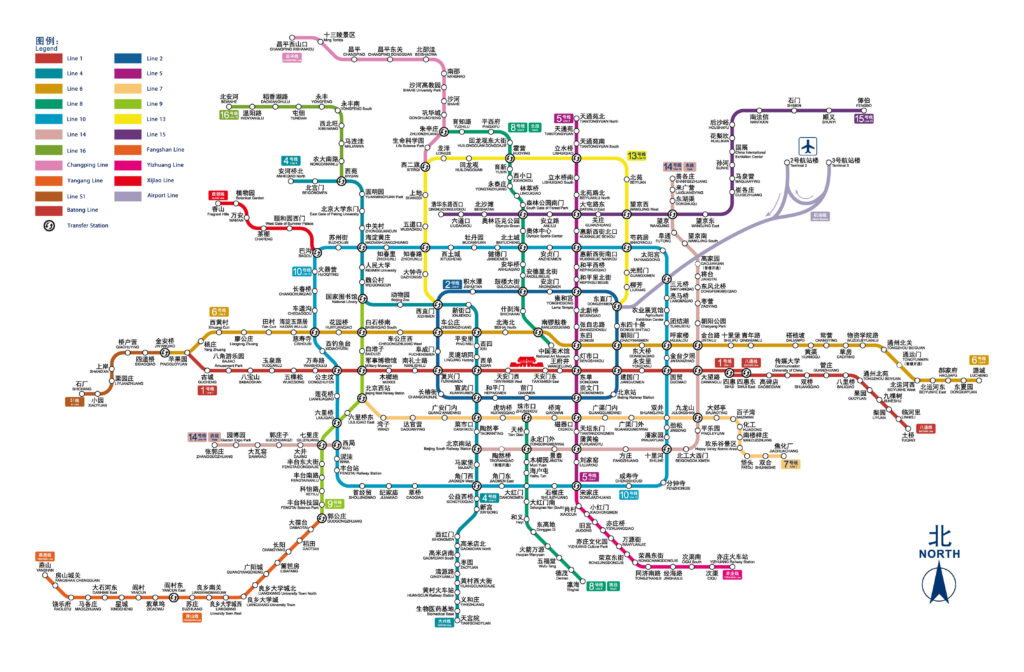
Anyone trying to find their way through the extensive public transportation network of the city should check out the Beijing Metro Map 2023. With this free PDF download, users can quickly see how the whole metro system is set up, including all lines and stops that can be used. This map makes it simple to plan routes, find stations, and pinpoint transfer places. The ability to visualize the connections between various lines makes it an excellent tool for gaining a comprehensive understanding of the overall system. Anyone can navigate Beijing’s complex metro system with the aid of this practical tool.
Public transport tickets in Beijing – Best types for travelers & actual prices
With Beijing’s well-developed network of public transportation, getting around the city is quick, simple, and hassle-free. Commuters are able to select the ticket that caters to their requirements the most effectively thanks to the availability of multiple options. If you want to travel about Beijing, here is a guide to the many types of tickets and their rates so that you may make an educated decision about which option is best for you.
In Beijing, the one-way or single-journey ticket is the most typical purchase for a ride on the public transportation system. These tickets are available for both adults and children and can be utilized for a single journey on any of the public transportation networks (metro, bus, or tram). Adult tickets for a single travel cost 2 RMB, whereas tickets for children only cost 1 RMB. It is essential that you are aware that these tickets may only be used for one specific voyage and cannot be redeemed for any other type of travel.
If you are going to be doing a lot of traveling in Beijing, you should probably look into getting a Beijing Public Transportation Card. This card is a reloadable card that can be utilized on all forms of Beijing public transportation, such as the metro, buses, and trams. At any of Beijing’s metro stations, for the price of 20 RMB, you can purchase the card. After that, you can add funds to the card at any metro station or convenience store that accepts the card. The card’s purchase price can be refunded, and it can be returned for a refund at any metro station, however, you will be charged an extra fee of 5 RMB.
An unlimited travel card is an excellent alternative for individuals who take the metro on a regular basis and travel frequently. With this card, you can ride the metro an infinite number of times within the specified time period, which could be one week, one month, or three months. The price of the card varies according to the length of the term covered by the pass:
- the price of the pass for one week is 45 RMB,
- the price of the pass for one month is 75 RMB
- the price of the pass for three months is 205 RMB.
At long last, visitors to Beijing now have the opportunity to buy a Beijing Tourist Card. During a period of three days, you can use this card to travel on the metro and bus networks without any restrictions. Discounts are also available at certain shops and tourist attractions when you use the card. The card costs 100 RMB and may be purchased at any metro station.
With a range of ticket options available, travellers in Beijing can choose the best option to fit their needs. From single journey tickets to limitless travel cards, there is something for everyone. With the help of this guide, you should now be able to make an educated decision and locate the most appropriate ticket for your travels throughout Beijing.
Timetables & Schedules of beijing Metro system
The daily hours for the Beijing Metro are 5:00 a.m. to 11:00 p.m. During peak hours, trains run every two to three minutes, while during off-peak hours they run every five to ten minutes. For people who need to travel after regular metro system working hours, buses are available. Nearly all of Beijing’s districts are covered by the metro system, which also connects to a number of the city’s attractions. The Beijing South Railway Station and Beijing Airport are also connected to the metro system.
What Are Other Options For Public Transportation In Beijing?
With a population of nearly 21 million, Beijing is a sizable city. So, it shouldn’t be a surprise that public transportation is an important part of city life. Although Beijing’s Metro is the most well-known and often utilized mode of public transit, it is not the only one available. There are many more public transportation options in Beijing that can be used to get around the city.
The Beijing bus system is the first alternative to the Beijing Metro. With a vast network of routes covering the entire city, Beijing’s buses offer a cheap and practical method to move around. Both regular and express buses run across the city, and tickets are relatively reasonably priced.
The Beijing bike-share program is an additional choice. With this system, users can rent bicycles from predetermined places and drop them off at any other station after their ride is complete. Students and other young people in the city love the city’s bike-share program in particular.
In Beijing, taxi services are very extensively accessible. Taxis are a great option for people who don’t want to use public transportation because they are quick, easy to use, and not too expensive. But keep in mind that traffic in Beijing can be very bad, so give yourself more time to get where you need to go.
Finally, there are several long-distance bus services that travel from Beijing to other cities in the area for individuals who want to leave the city and explore the surrounding places. These buses are frequently cosy and affordable, making them a fantastic choice for anyone looking to explore the area.
In conclusion, Beijing has a lot of different ways to get around, such as the subway, buses, bike-share, taxis, and luxury cars. Although each of these choices has pros and cons of its own, they all provide a practical means of getting around the city.
How To Get From Beijing Capital International Airport (PEK) To The City Center With Public Transport?
Getting from Beijing Capital International Airport to the city center with public transportation is an easy and convenient way to travel. With a few simple steps, you can be on your way to explore all that the city has to offer.
First, you will need to purchase your ticket. Tickets can be bought at the Airport Express ticketing counters inside the terminal. You can pay for your ticket with cash, credit, or a Beijing transportation card. Once you have your ticket, you can proceed to the Airport Express station.
The Airport Express line runs from the airport to Sanyuanqiao Station, which is closest to the city center. The journey takes about 20 minutes and runs from 6:30 a.m. to 11:30 p.m. Along the way, you will have the opportunity to take in the sights of Beijing. Once you arrive at Sanyuanqiao Station, you can transfer to the Beijing Metro. Here, you will be able to catch a train to any destination within the city. The Beijing Metro is an affordable and efficient way to get around. It runs from 5:00 a.m. to 11:00 p.m. and offers both express and local lines. Alternatively, you can take a taxi from Sanyuanqiao Station to your destination. While this may be more expensive than the metro, it is often faster and more convenient.
No matter which option you choose, getting from Beijing Capital International Airport to the city center with public transportation is a straightforward process. With the Airport Express, Beijing Metro, and taxis, you can easily and quickly get to wherever you need to go.
What kind of sightseeing do you have to see if you visit Beijing for THE first time?
Beijing is a historic city with several well-known landmarks. Everyone can find something to enjoy in this huge Chinese metropolis, which features everything from the ancient Great Wall of China to the cutting-edge Olympic Park. It can be challenging to compile a short list of Beijing’s must-see sites due to the city’s abundance of outstanding attractions. Here are some of Beijing’s best tourist destinations, though.
Unquestionably, the Great Wall of China is among Beijing’s most well-known landmarks. This ancient building is the world’s longest man-made structure, measuring more than 8,800 kilometers. Visitors have the option of taking a cable car trip for a breathtaking view or hiking across different sections of the wall.
- The Forbidden City in Beijing is yet another must-see destination. The largest and best-preserved collection of Chinese antique structures may be found in this former royal palace. With more than 8,000 chambers, the Forbidden City was named a World Heritage Site in 1987.
- The Summer Palace in Beijing is another destination on the itinerary. The royal family used to spend their summers in this royal garden, which is today a well-liked tourist attraction. The breathtaking gardens, which include the famous Long Corridor, Kunming Lake, and the Marble Boat, are open for exploration by guests.
- Another must-see site is the Tiananmen Area, a sizable public square in the centre of Beijing. The Great Hall of the People, Chairman Mao’s Mausoleum, and the Monument to the People’s Heroes are all located on this famous square.
- Olympic Park in Beijing is also worth a visit. This cutting-edge park, which includes the recognizable Bird’s Nest Stadium, was constructed for the 2008 Summer Olympics. The area is open for exploration, and tours of the Olympic Village are available.
- The Temple of Heaven is a must-see attraction in Beijing, to finish. This 15th-century collection of religious structures is now a UNESCO World Heritage Site. Visitors are welcome to stroll around the lovely grounds and see the famous Hall of Prayer for Good Harvests.
These are a few of Beijing’s popular tourist destinations. Beijing has something for everyone, whether they are interested in ancient history, contemporary architecture, or natural beauty. When traveling to this magnificent city, be sure to include these top attractions on your list.
Summary of our tour guide for Beijing
China’s capital, Beijing, is one of the most populated cities in the world. Many historical and cultural landmarks may be found there, and its history stretches back to 1045 BC. A multitude of transportation choices are available in this contemporary metropolis. Beijing has a variety of public transportation options, including the metro, buses, taxis, and a bike-sharing program. Because it moves quickly and covers a huge area, the subway is the most well-liked and effective way to move around the city. In addition to taxis, buses are also frequently used for short trips. For those who favor cycling, there is also the option of using the bike-sharing program. All of these different public transportation options make Beijing an easy and enjoyable place to visit.
Top 5 FAQs and answers about Beijing public transport?
- What kinds of transportation are offered in Beijing?
- An extensive network of public transportation options, including buses, subways, taxis, and bike-sharing programs, is available in Beijing. These services are all user-friendly, dependable, and reasonably priced. The most used mode of transportation in Beijing is the subway because it is quick and convenient.
- How can I pay for public transportation in Beijing?
- Answer: The Yikatong card can be used to pay for the majority of Beijing’s public transportation. It is possible to pay for cabs, buses, and metro rides with this prepaid card. A Yikatong card can be purchased at any subway stop or convenience store.
- Is Beijing’s public transportation secure?
- Yes, Beijing’s public transportation is generally secure. All of the cabs, subways, and buses receive regular maintenance and are staffed. For increased security, many of the buses and subways are equipped with CCTV cameras.
- In Beijing, are there any English-language signs?
- Yes, Beijing does have signage in English. The buses and cabs in Beijing, as well as the metro stations, include English-language signs. The apps for the bike-sharing programmes are also available in English, which makes them simple to use.
- How much does Beijing public transportation cost?
- The price of public transportation in Beijing varies depending on the mode of transportation. Taxis often cost between 10-15 yuan a kilometre, while buses and subways typically cost around 3 yuan every ride. Prices for bike-sharing services start at just 0.5 yuan per hour, making them often quite reasonable.
Useful links

